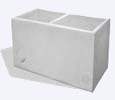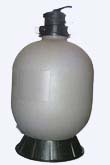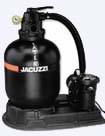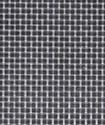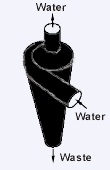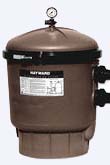10. Solid Waste
Particle Size and Equipment
Photos Courtesy of Aquatic Ecosystems, Inc
|
|
|
|
|
| Sedimentation |
|
|
|
|
|
Settling Tank |
> 100 |
none |
| Granular Media |
|
|
|
|
|
Bead Filter |
> 50 |
moderate |
|
|
Sand Filter |
10 - 50 |
high |
| Microscreens |
|
|
|
|
|
|
> 75 |
low |
| Hydrocyclones |
|
|
|
|
|
Cyclone |
1 -75 |
high |
| Porous Media |
|
|
|
|
|
|
> 0.1 |
very high |
|
|
|
1 - 10 |
moderate |
| Other |
|
|
|
|
|
|
< 30 |
none |
|
|
Ozonator |
< 30 |
none |
|
Removal of solid waste in recirculation aquaculture is complicated by the fact that the loosely aggregated fecal material and uneaten food tend to break into small pieces in the water. Understanding the role of particle size in the removal process is key to efficient solids removal.
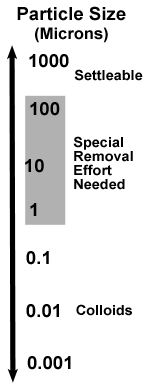 |
Relatively large particles, those over 100 microns (micrometers), are considered settleable solids, meaning that if water velocity is reduced they will settle to the bottom by gravity. This settling or sedimentation is accomplished by allowing the water to slow, usually in a sump tank, with the result that these big particles drop out. This process can be encouraged by running the water through tubes or over weirs in the settling tank. The relatively long retention times (slow flow rate) in a settling tank, which is needed for settling to occur, is a drawback which has been answered by diverting some of the flow "offline" (temporarily out of the recirculation loop) so settling can occur without affecting overall flow in the system. Wherever the solids settle out they must be periodically removed by draining off the sludge with the unwanted loss of water, as well. While settling is cheap and simple, removing particles only larger than 100 microns is inadequate, too much solid material remains. So, sedimentation may be used as a primary or pretreatment, but can not be used as the only solids removal technique.
Adequate solids removal for recirculation aquaculture requires that particle sizes down to about 50 -75 micrometers be removed. Water with only particles <50 microns remaining will seem somewhat cloudy and turbid, but is sufficiently clean for production recirculation aquaculture (but not for display, as in a public aquarium). The most popular removal equipment for smaller particles falls into two categories: granular media and microscreens. These will be discussed in detail in the following chapter. A distant third in popularity is the hydrocyclone. The hydrocylcone works by converting the water velocity into a circular motion in a cone. Solids in the spinning water are thrown to the sides of the cone by centrifugal force. At the sides, the velocity is slower and the solids sink to the bottom of the cone while the cleaner water exits the top. Essentially, a hydrocyclone works by forcing sedimentation in an environment with an increased gravitational force (simulated by centrifugal force), not unlike a centrifuge or a carnival ride. Hydrocyclones are widely used in industry for separating solids from liquids. The drawback of hydrocyclones for recirculation aquaculture is that they result in a high head loss (require extra pumping power), increasing the energy expense.
Another category of solids removal equipment is porous media. While they have some special applications, they are not appropriate for production recirculation aquaculture. One type of porous media filter is the diatomaceous earth or D.E. filter. Diatomaceous earth is a mineral deposit consisting almost entirely of the frustules (microscopic shells) of marine phytoplankton called diatoms. These tiny frustules are mainly silica, like sand, and provide a very fine media for straining out very small solids (down to 0.1 microns!). They produce sparkling clear water, but clog very rapidly unless the water is pretreated to move larger particles. While useful for display systems, they are "overkill" for production recirculation aquaculture. Another porous media filter is the cartridge filter. A cartridge filter is like an auto oil filter which has a replaceable plastic media that traps solids. It has specialized applications in small experimental systems, but is seldom used in production aquaculture.
 |
 |
Finally, there is another category of filters that remove the smallest particles (< 30 microns) and colloids. This includes the foam fractionators and ozonators (ozonation is primarily a disinfection procedure and will be discussed in detail in later chapters). While it is generally accepted that recirculation aquaculture systems can be successfully operated when only particles down to 50 microns are removed, many operators believe that it is very helpful to scrub the water with a foam fractionator or ozonator to minimize problems, maximize production, and reduce water replacement that would be used to flush out these components.
The Waste
Once the solids are diverted from the recirculation system, they must be disposed of properly. The solid waste is simply fish manure, but it differs from other animal manures in that it is 99% water. Since it is essentially dirty water, it can be disposed of through a municipal sewer system. This works well for small operations. For larger fish farms, this may be too expensive or they may be in a rural setting without access to a sanitary sewage plant. The wastewater may be diverted temporarily to a lagoon for settling, but at some point it will need to flow into a stream at which point it becomes pollution that must be permitted with the state environmental agency. An alternative is land disposal. If the soil drains well or "percolates", the liquid fraction of the waste may be disposed of through some sort of leach field or sprayed on pasture land. At this point, the fish farmer must meet environmental regulations designed to protect ground water. In some areas, the nitrate content of recirculation aquaculture may prevent ground disposal.
Assignment 10
